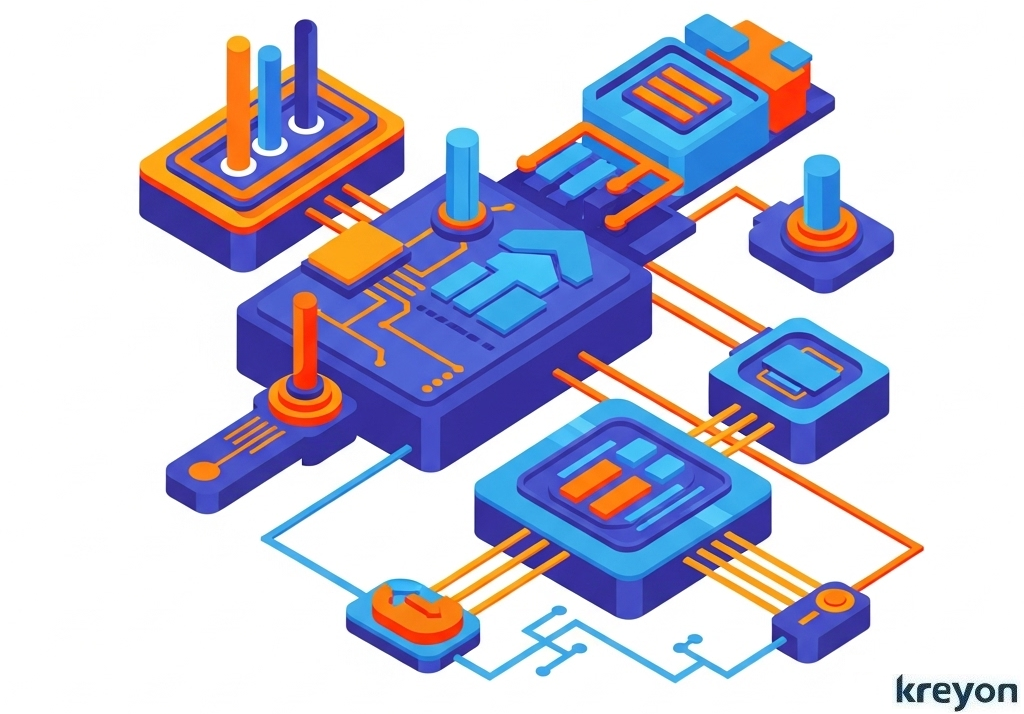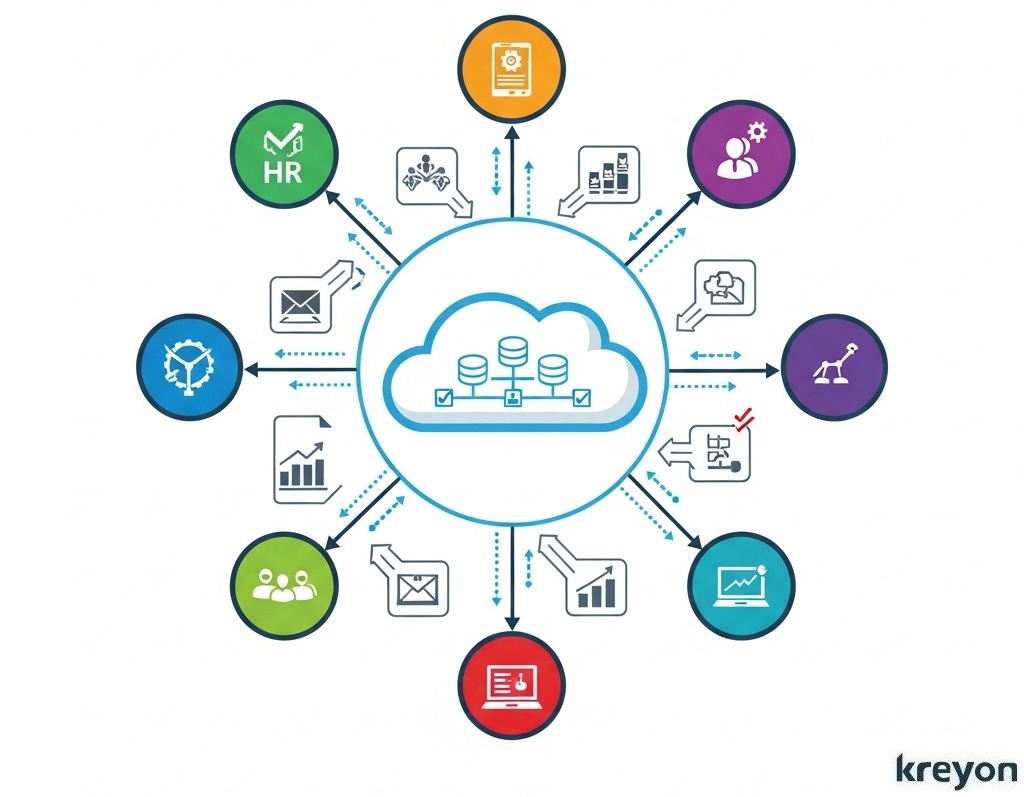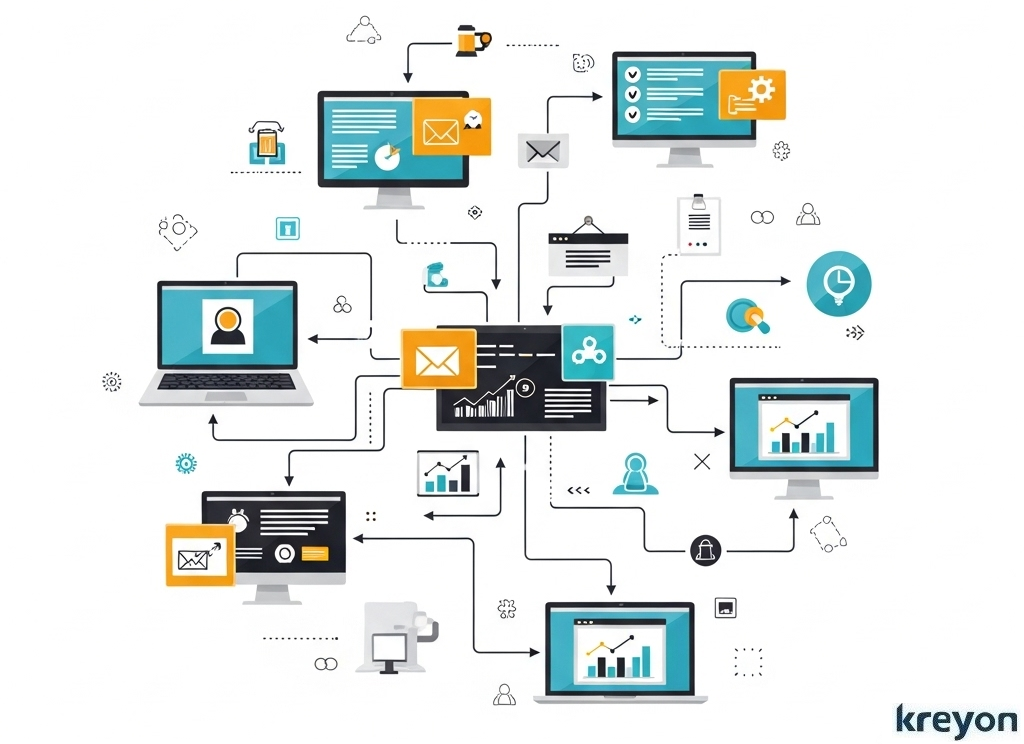Enterprise Workflow Automation Tools & Best Practices for the Modern Business

In a hyper-competitive landscape, speed is strategy. Today agility and efficiency are no longer luxuries but necessities, mastering Enterprise Workflow Automation isn’t just an advantage, it’s the bedrock of sustained success.
Yet, many organizations remain tangled in outdated, manual workflows that slow progress and obscure insights. Enterprises must not only move fast but move smart streamlining operations, enhancing accuracy, and staying nimble in the face of rapid technological change.
At Kreyon Systems, we see a clear path forward: Enterprise Workflow Automation (EWA), a strategic enabler of digital transformation and a critical lever for performance.
But EWA is not about slapping automation onto isolated tasks. It’s about orchestrating connected, intelligent workflows that span teams, tools, and technologies. Done right, EWA redefines how work gets done, more efficiently, consistently, and insightfully.
This guide explores what makes EWA essential, the tools reshaping the enterprise automation landscape, and the best practices to ensure a successful transformation.
Redefining Workflow Automation
Enterprise Workflow Automation isn’t simple robotic task replacement. It’s the comprehensive use of technology to design, execute, and manage complex business processes across an organization—often crossing departmental, geographic, and system boundaries.
At its core, EWA is about end-to-end process orchestration. That means:
-
Process Mapping & Modeling: Identifying inefficiencies before automating them.
-
Rule-Based Execution: Automating decisions based on clear business logic.
-
System Integration: Ensuring fluid data movement between platforms like ERP, CRM, HRIS, and legacy systems.
-
Orchestration & Human Handoff: Coordinating multi-step workflows with built-in flexibility for human judgment where needed.
The result? A smarter, faster, more scalable operational backbone.
Why Workflow Automation Is No Longer Optional

1. Strategic Agility
In an era where product cycles shrink and market dynamics shift overnight, agility wins. EWA empowers businesses to adapt faster—launching products, reallocating resources, or pivoting processes with speed and precision.
2. Foundation for AI-Driven Transformation
Workflow automation lays the groundwork for deeper digital transformation. Once foundational processes are automated, companies can layer on AI, machine learning, and predictive analytics to transform data into foresight—and action.
3. Risk and Compliance, Managed
Manual processes carry risk. EWA enforces standardization, traceability, and real-time compliance monitoring, making audit-readiness a built-in feature rather than a scramble.
4. Human-Centered Productivity
By relieving teams of repetitive tasks, EWA enables people to focus on higher-value work, solving problems creatively, innovating, and delivering better customer experiences. This isn’t just good for the business; it’s good for talent retention, too.
5. Cost and Scalability Gains
Fewer errors, faster cycles, and smarter use of resources create measurable savings. As business volume grows, automated workflows scale effortlessly—without bloating headcount or sacrificing control.
What to Look for in a Modern EWA Platform
The market is full of tools claiming to “automate workflows.” The right platform should do far more. As you evaluate solutions, prioritize platforms that offer:
-
Low-Code/No-Code Builders: Empower non-technical users to design and deploy workflows.
-
iPaaS-Grade Integration: Seamless data flow between new and legacy systems.
-
AI & ML Capabilities: For intelligent document processing, decision-making, and predictive automation.
-
Scalability & Flexibility: Adaptable systems that evolve with your needs.
-
Real-Time Analytics: Clear performance metrics and visibility.
-
Enterprise-Grade Security: Built-in compliance and data protection for peace of mind.
Best-in-Class EWA Tools

The ecosystem of EWA tools is vast, and diverse use cases demand varied capabilities. Here are a few standout platforms:
Robotic Process Automation (RPA)
-
UiPath: Full-spectrum automation with AI integration.
-
Automation Anywhere: Combines RPA, analytics, and intelligent document processing.
-
Microsoft Power Automate: Ideal for Microsoft-heavy environments.
Business Process Management (BPM)
-
Enables complex workflow modeling, orchestration, and optimization.
Integration Platform as a Service (iPaaS)
-
Workato: Combines powerful integrations with workflow logic.
-
Zapier: Lightweight, cloud-native automation for departmental use.
Kreyon Systems in Action
At Kreyon, we go beyond off-the-shelf automation. We design tailored, intelligent systems that automate mission-critical functions, from AI-enabled recruitment pipelines and HR workflows to financial operations like accounts receivable, payables, and compliance reporting.
Our solutions aren’t just efficient; they’re engineered for business impact.
Implementing EWA: A Practical Playbook
1. Define the “Why” First
Start with purpose. What are you trying to improve—cycle time? Error rates? Customer satisfaction? Clarity of objective is key to meaningful automation.
2. Start Small, Prove Value
Pick one process with a clear pain point and high ROI potential. Use early wins to build momentum and buy-in.
3. Map Before You Automate
Automating a broken process just digitizes inefficiency. Use visual mapping to understand, simplify, and optimize before implementing tech.
4. Engage Stakeholders Early
Automation can provoke anxiety. Make it a participatory process show how automation augments, not replaces, human roles.
5. Upskill Your Workforce
Invest in training. Teach your teams how to work alongside automation, and even how to build and optimize it themselves.
6. Plan for the Exceptions
Design workflows that handle real-world complexity—when things go wrong, someone needs to know what to do.
7. Monitor, Measure, Improve
Automation isn’t a set-and-forget strategy. Build feedback loops to continually refine workflows.
8. Keep Data Clean and Connected
Automation’s success depends on data quality. Invest in governance, integration, and real-time synchronization across platforms.
Challenges to Anticipate (And How to Overcome Them)

While the benefits are clear, implementing EWA can present challenges:
-
Legacy System Headaches: Integration is tough—but not impossible. Our teams specialize in bridging these gaps with custom connectors.
-
Change Resistance: Transparent communication and leadership sponsorship are key.
-
Scope Creep: Stay disciplined. Automate incrementally and with purpose.
-
Data Gaps: Clean and structure your data before building workflows.
-
Skill Shortages: If internal capacity is lacking, work with a trusted partner.
Conclusion: The Automation Advantage
Enterprise Workflow Automation is no longer a competitive edge, it’s a competitive requirement. For organizations ready to accelerate growth, reduce operational drag, and unlock human potential, EWA offers a clear path forward.
At Kreyon Systems, we bring deep expertise in building intelligent, scalable, and integrated automation frameworks tailored to your business. From initial strategy to hands-on implementation and optimization, we partner with you every step of the way.
Are you ready to design the future of your enterprise workflows with Kreyon Systems? Let’s build something transformative together, please contact us for any queries.
